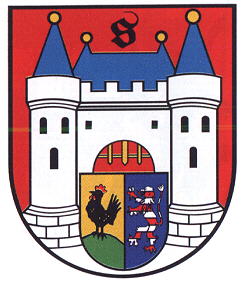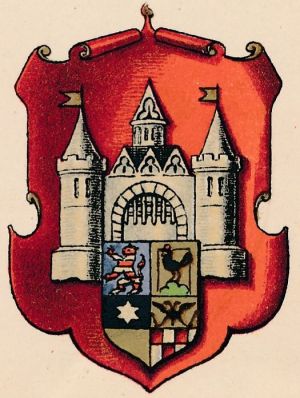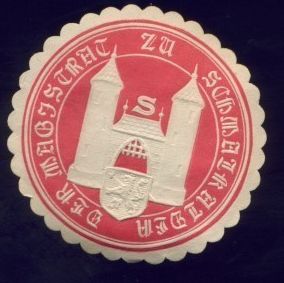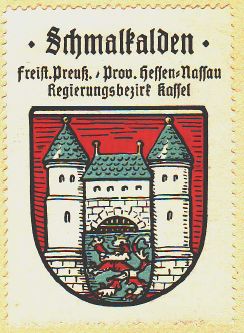Schmalkalden
SCHMALKALDEN
State : Thüringen
District (Kreis) : Schmalkalden-Meiningen
Additions : 1950 Weidebrunn; 1961 Volkers; 1973 Reichenbach; 1978 Näherstille; 1994 Asbach, Grumbach, Mittelschmalkalden (1950 Aue, Haindorf), Mittelstille (1975 Breitenbach), Möckers; 2008 Wernshausen (1994 Helmers, Niederschmalkalden); 2018 Springstille
| German | In Rot eine zweitürmige silberne Burg mit blauem Dach und vier goldenen Turmknäufen, im offenen Tor ein gespaltener Schild, darin vorn in Gold eine schwarze Henne mit rotem Kamm und roten Lappen auf grünem Dreiberg, hinten in Blau ein neunmal von Silber und Rot geteilter, golden gekrönter Löwe. |
| English | No blazon/translation known. Please click here to send your (heraldic !) blazon or translation |
Origin/meaning
Schmalkalden was a possession of both the Counts of Henneberg and the Counts of Hessen from 1360-1583. From 1583-1866 it was only part of Hessen, and from 1866-1918 of the Prussian province of Hessen-Nassau.
The above arms are based on the oldest seal of the city, dating from 1337 and showing a city gate, with in the gate a small shield with the arms of Henneberg (rooster on a mountain). Later seals combined the arms of Henneberg with Hessen (striped lion), as shown in the above arms. The small S above the gate is the town's initial.
After 1583 the arms showed only the lion of Hessen in the small shield. These arms were used until 1993, when the above arms were adopted.
| The arms in a manuscript from +/- 1730 |
The arms in an 1884 book |
| The arms from 1583-1993 |
Seal from around 1900 |
| The arms by Hupp in the Kaffee Hag albums +/- 1925 |
On a postcard from the early 1990s the arms were shown in the wrong colours |
Literature: Bensing et al., 1984; Hupp, O: Kaffee Hag albums, 1920s






